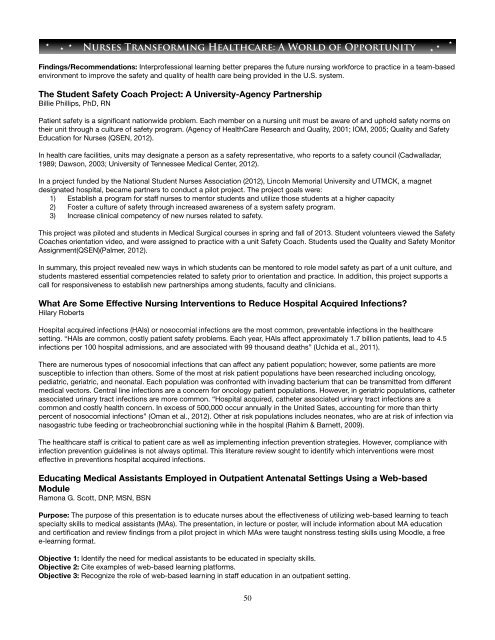2014 Tennessee Nurses Association Conference Yearbook
Create successful ePaper yourself
Turn your PDF publications into a flip-book with our unique Google optimized e-Paper software.
NURSES TRANSFORMING HEALTHCARE: A WORLD OF OPPORTUNITY<br />
Findings/Recommendations: Interprofessional learning better prepares the future nursing workforce to practice in a team-based<br />
environment to improve the safety and quality of health care being provided in the U.S. system.<br />
The Student Safety Coach Project: A University-Agency Partnership<br />
Billie Phillips, PhD, RN<br />
Patient safety is a significant nationwide problem. Each member on a nursing unit must be aware of and uphold safety norms on<br />
their unit through a culture of safety program. (Agency of HealthCare Research and Quality, 2001; IOM, 2005; Quality and Safety<br />
Education for <strong>Nurses</strong> (QSEN, 2012).<br />
In health care facilities, units may designate a person as a safety representative, who reports to a safety council (Cadwalladar,<br />
1989; Dawson, 2003; University of <strong>Tennessee</strong> Medical Center, 2012).<br />
In a project funded by the National Student <strong>Nurses</strong> <strong>Association</strong> (2012), Lincoln Memorial University and UTMCK, a magnet<br />
designated hospital, became partners to conduct a pilot project. The project goals were:<br />
1) Establish a program for staff nurses to mentor students and utilize those students at a higher capacity<br />
2) Foster a culture of safety through increased awareness of a system safety program.<br />
3) Increase clinical competency of new nurses related to safety.<br />
This project was piloted and students in Medical Surgical courses in spring and fall of 2013. Student volunteers viewed the Safety<br />
Coaches orientation video, and were assigned to practice with a unit Safety Coach. Students used the Quality and Safety Monitor<br />
Assignment(QSEN)(Palmer, 2012).<br />
In summary, this project revealed new ways in which students can be mentored to role model safety as part of a unit culture, and<br />
students mastered essential competencies related to safety prior to orientation and practice. In addition, this project supports a<br />
call for responsiveness to establish new partnerships among students, faculty and clinicians.<br />
What Are Some Effective Nursing Interventions to Reduce Hospital Acquired Infections?<br />
Hilary Roberts<br />
Hospital acquired infections (HAIs) or nosocomial infections are the most common, preventable infections in the healthcare<br />
setting. “HAIs are common, costly patient safety problems. Each year, HAIs affect approximately 1.7 billion patients, lead to 4.5<br />
infections per 100 hospital admissions, and are associated with 99 thousand deaths” (Uchida et al., 2011).<br />
There are numerous types of nosocomial infections that can affect any patient population; however, some patients are more<br />
susceptible to infection than others. Some of the most at risk patient populations have been researched including oncology,<br />
pediatric, geriatric, and neonatal. Each population was confronted with invading bacterium that can be transmitted from different<br />
medical vectors. Central line infections are a concern for oncology patient populations. However, in geriatric populations, catheter<br />
associated urinary tract infections are more common. “Hospital acquired, catheter associated urinary tract infections are a<br />
common and costly health concern. In excess of 500,000 occur annually in the United Sates, accounting for more than thirty<br />
percent of nosocomial infections” (Oman et al., 2012). Other at risk populations includes neonates, who are at risk of infection via<br />
nasogastric tube feeding or tracheobronchial suctioning while in the hospital (Rahim & Barnett, 2009).<br />
The healthcare staff is critical to patient care as well as implementing infection prevention strategies. However, compliance with<br />
infection prevention guidelines is not always optimal. This literature review sought to identify which interventions were most<br />
effective in preventions hospital acquired infections.<br />
Educating Medical Assistants Employed in Outpatient Antenatal Settings Using a Web-based<br />
Module<br />
Ramona G. Scott, DNP, MSN, BSN<br />
Purpose: The purpose of this presentation is to educate nurses about the effectiveness of utilizing web-based learning to teach<br />
specialty skills to medical assistants (MAs). The presentation, in lecture or poster, will include information about MA education<br />
and certification and review findings from a pilot project in which MAs were taught nonstress testing skills using Moodle, a free<br />
e-learning format.<br />
Objective 1: Identify the need for medical assistants to be educated in specialty skills.<br />
Objective 2: Cite examples of web-based learning platforms.<br />
Objective 3: Recognize the role of web-based learning in staff education in an outpatient setting.<br />
50

















